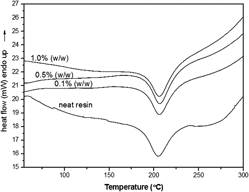Crossref Citations
This article has been cited by the following publications. This list is generated based on data provided by
Crossref.
Brown, Emily A.
and
Rider, David A.
2017.
Pegylated Polybenzoxazine Networks with Increased Thermal Stability from Miscible Blends of Tosylated Poly(ethylene glycol) and a Benzoxazine Monomer.
Macromolecules,
Vol. 50,
Issue. 17,
p.
6468.
Ipek, Halil
and
Hacaloglu, Jale
2018.
The effect of aromatic diboronic acid on characteristics of polybenzoxazine based on phenol and 4-aminomethylbenzoate.
Journal of Polymer Research,
Vol. 25,
Issue. 12,
García-Martínez, V.
Gude, M.R.
and
Ureña, A.
2018.
Understanding the curing kinetics and rheological behaviour of a new benzoxazine resin for carbon fibre composites.
Reactive and Functional Polymers,
Vol. 129,
Issue. ,
p.
103.
Galkina, Anna N.
Sergeev, Alexander A.
Leonov, Andrei A.
Romashko, Roman V.
Jiang, Jyh Chiang
and
Liaw, Der Jang
2018.
Static and Dynamic Sorption of Free Amines on Surface of Carbon Nanotubes Modified with Nanolayers of Polymer.
Defect and Diffusion Forum,
Vol. 386,
Issue. ,
p.
244.
Relinque, J. J.
Romero-Ocaña, Ismael
Navas-Martos, Francisco J.
Delgado, F. J.
Domínguez, M.
and
Molina, S. I.
2020.
Synthesis and Characterisation of Acrylic Resin-Al Powder Composites Suitable for Additive Manufacturing.
Polymers,
Vol. 12,
Issue. 8,
p.
1642.
García-Martínez, V.
R.Gude, M.
Calvo, S.
Martínez-Miranda, M.R.
and
Ureña, A.
2020.
Influence of graphene nanoplatelets on curing kinetics and rheological properties of a benzoxazine resin.
Materials Today Communications,
Vol. 24,
Issue. ,
p.
100990.
Lochab, Bimlesh
Monisha, Monisha
Amarnath, Nagarjuna
Sharma, Pratibha
Mukherjee, Sourav
and
Ishida, Hatsuo
2021.
Review on the Accelerated and Low-Temperature Polymerization of Benzoxazine Resins: Addition Polymerizable Sustainable Polymers.
Polymers,
Vol. 13,
Issue. 8,
p.
1260.
Aktitiz, İsmail
Aydın, Kadir
Darıcık, Fatih
and
Topcu, Alparslan
2022.
Production of different metal oxide nanoparticle embedded polymer matrix composite structures by the additive manufacturing technology and investigation of their properties.
Polymer Composites,
Vol. 43,
Issue. 11,
p.
7826.
Abdous, Slimane
Derradji, Mehdi
Khiari, Karim
Mehelli, Oussama
Zegaoui, Abdeljalil
and
Liu, Wenbin
2023.
Design of advanced and highly effective partially bio-energetic polybenzoxazines as the next generation of reactive structure materials.
Journal of Energetic Materials,
p.
1.
Carlevaris, Davide
Menapace, Cinzia
Straffelini, Giovanni
and
Fambri, Luca
2023.
Characterization of benzoxazine resins for brake pad friction materials manufacturing.
Journal of Thermal Analysis and Calorimetry,
Vol. 148,
Issue. 3,
p.
767.
Carlevaris, Davide
Fambri, Luca
Menapace, Cinzia
and
Straffelini, Giovanni
2024.
Assessment of benzoxazine resins as brake pad friction material binder: Tribological properties and PM emission.
Tribology International,
Vol. 194,
Issue. ,
p.
109531.





